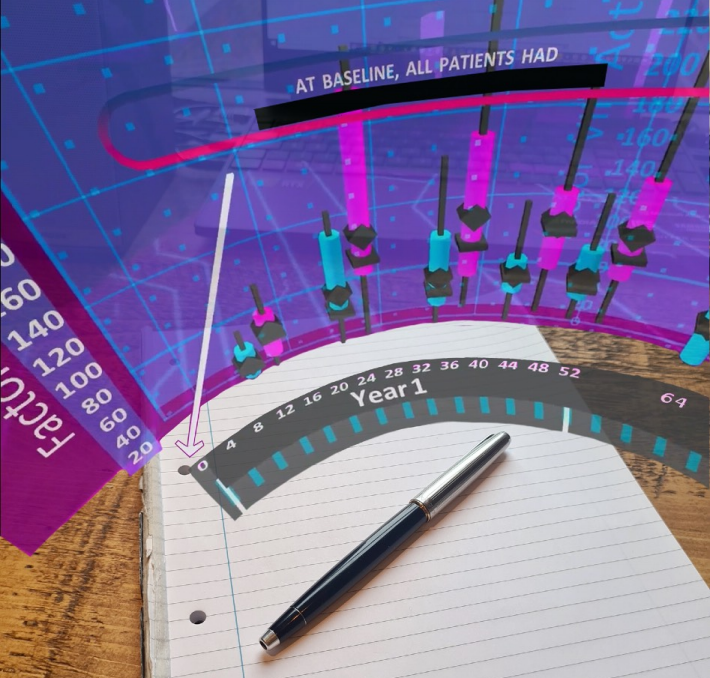FEBRUARY 2021
Around one third of doctors expect to use online rather than face-to-face channels as their primary route for engaging with biopharma companies in the future, post-Covid. This clearly means that two thirds expect to revert to face-to-face calls with company representatives when the pandemic is under control (https://pmsociety.org.uk/webinar-industry-engagement-post-covid-19-event-report/). Augmented reality as a communication medium is highly suited to both face-to-face and online engagement with physicians but its potential is far from having been recognised, particularly because it can be experienced on a wide range of devices, from laptops to mobile peripherals such as phones or tablets.

AUGMENTED REALITY
Augmented Reality (AR) is a visual medium of communication which allows viewers to explore digital content in 3D space, making it an ideal means to examine anatomy and related physiological processes- essential for demonstrating a drug’s mechanism of action. Less obvious, but equally significant, is its ability to present data in three dimensions, which opens up the possibility of showing a medicine’s clinical data in new and more powerful ways.
When showing a physician an AR experience, a very common first reaction is of amazement and wonder, which gets the conversation with the rep or MSL off to a very good start. The AR experience itself then forms the anchor or centrepiece for the remaining discussion, particularly given the ability of the rep to control the subsequent movement and perspective of the viewed material, by moving the mobile device around the virtual objects that comprise the experience.
A very important aspect of AR is its ability to be used effectively not only in face-to-face interactions but also online via Zoom, Teams or other web-based remote conferencing tools. This means that marketing teams can develop AR material certain in the knowledge that it can be used irrespective of the reps’ preferred communication channel or the state of the pandemic in his or her area. A further consideration is the rep’s role in presenting the material. Far from being a substitute or crutch for the rep’s abilities, AR is best used as a supplementary component of a confident, rep-led discussion. The rep is able to take the physician on a journey through a fascinating dimension, emphasising key points and concepts on the way. This can be done equally effectively in the doctor’s office, or on a Zoom call.
AR CLINICAL DATA
Let’s return to the topic of clinical data for a pharmaceutical product. This is normally presented to physicians in journals, in black and white and in 2D. It may also be presented by an investigator, often armed with some Powerpoint slides. Sadly, this can sometimes be a tedious experience and is seldom an interactive one. The use of AR can immerse the viewer in the data – with interesting charts and graphs springing up in 3 dimensions according to her wishes and allow specific data points, trends or statistical insights to be explored and examined. It can also allow the appearance of related clinical images to provide context or to reinforce the results being viewed. It can also, if desired, be combined with a few words from the lead trial investigator, to add impact. The whole experience is high impact, immersive and memorable and, to ensure consistency of delivery, can be programmed to include audio, visual or haptic prompts for the user, to make sure that complex data is presented logically and clearly. It is worth noting that such an experience can also be an attractive feature of an on-line event such as a webinar, providing high scientific value as well as a degree of entertainment.
MECHANISM OF ACTION
The second area in which AR excels is mechanism of action (MOA). It is well-known that physicians tend to prescribe a product more often if they understand its mechanism of action and there are plenty of beautifully animated MOA videos produced every year to achieve this. The advantage of AR however, is that provides an immersive 3D experience of the MOA and allows the viewer to move and view virtual objects from all angles. The AR MOA experiences that work best are often the shortest, most concise ones, that capture a key piece of anatomy and physiological process to demonstrate the action of the drug which makes it unique. This could be an AR clip lasting 20 seconds but, importantly, the viewing experience is under the control of the rep and so it can be paused and explored from any angle, at any moment, for as long as the viewer wishes. The result of all this is that the scientific content has greater impact and the engagement time of the rep with the doctor tends to be prolonged.
CLINICAL IMPACT
The third area of interest for AR is demonstrating the Clinical Impact of a medicine. This is, arguably, a part of the MOA but is perhaps best conceived as the physical impact of the MOA. It is essentially a 360-degree view of the target tissue or organ in situ, as it responds to treatment. Examples include tumour shrinkage, brain lesion reduction or inflammation reduction. This normally comprises a short, 20 second animation, allowing the physician and rep to observe and explore the impact of treatment. This can be a nice way to round off a call with the physician or as a focal point for a short, high impact call.
For additional information on any aspect of AR/VR/XR in Biopharma and MedTech, please contact:
Mark Archer
